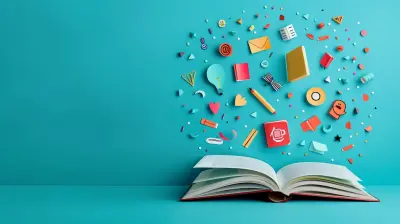How to Use Visual Aids to Help Students with Learning Disabilities
25 June 2025
Learning can be a challenge for some students, especially those with learning disabilities. Traditional teaching methods don’t always work for everyone, and that’s where visual aids come in. Visual aids can be game-changers, making complex concepts easier to understand, remember, and apply.
But how exactly do you use visual aids to help students with learning disabilities? Let’s dive in and explore practical strategies that educators and parents can use to make learning more accessible and engaging.

Why Visual Aids Matter for Students with Learning Disabilities
Students with learning disabilities often struggle with reading, writing, processing information, or retaining knowledge. Standard classroom techniques might not be enough for them to grasp concepts effectively.Visual aids—such as charts, diagrams, flashcards, and videos—help bridge this gap by presenting information in a way that’s easier to process. They turn abstract ideas into something tangible, making learning less stressful and more engaging.
Benefits of Using Visual Aids
1. Enhances Understanding – Visual aids simplify complex ideas, making them easier to comprehend.2. Improves Retention – People remember pictures better than words. Visuals help students retain and recall information more effectively.
3. Engages Different Learning Styles – Some students learn best through visuals rather than text or lectures.
4. Reduces Anxiety and Frustration – Struggling with reading or writing can be stressful. Visuals offer alternative ways to understand concepts without pressure.
5. Encourages Independence – With visual cues, students often need less assistance, boosting their confidence.

Types of Visual Aids for Students with Learning Disabilities
Not all visual aids are created equal. Different students respond to different types of visuals depending on their specific challenges. Here are some of the most effective ones:1. Graphic Organizers
Graphic organizers, such as mind maps and Venn diagrams, help students structure their thoughts and see connections between ideas. These tools are especially helpful for students who struggle with organization and comprehension.💡 Example: A “story map” can help students summarize a book by breaking it into characters, setting, problem, and solution.
2. Flashcards
Flashcards are a simple yet powerful tool for reinforcing information. They work well for vocabulary, math facts, and even historical dates. Since they provide bite-sized information, they prevent students from feeling overwhelmed.💡 Example: Using picture flashcards for words can help students with dyslexia associate images with meanings.
3. Charts and Diagrams
Charts simplify complex information, making it visually appealing and digestible. Timelines, flowcharts, and labeled diagrams can be particularly useful for subjects like history and science.💡 Example: A life cycle chart can help a student understand how a butterfly transforms from a caterpillar to an adult.
4. Visual Schedules and Checklists
Many students with learning disabilities struggle with organization and time management. Visual schedules and checklists help break tasks into manageable steps, making it easier for students to follow instructions.💡 Example: A daily schedule with pictures of activities can help students with ADHD stay on track.
5. Infographics
Infographics present information in an engaging and visually appealing way. They are great for summarizing key points and making information more accessible.💡 Example: A colorful infographic about the water cycle can help students grasp the process without reading large chunks of text.
6. Videos and Animations
Some students absorb information better when they see it in motion. Educational videos and animations make learning interactive, increasing engagement and comprehension.💡 Example: An animated math tutorial can explain fractions in a fun and engaging way.
7. Color-Coding Techniques
Using different colors for different subjects, categories, or concepts can make information easier to process and organize.💡 Example: Highlighting different parts of speech in various colors can help students with dyslexia learn grammar more effectively.

How to Effectively Use Visual Aids in Teaching
Just introducing visual aids isn't enough. You need to know how to use them effectively. Here are some practical tips:1. Keep It Simple
Don’t overwhelm students with too much information in one visual. Keep it clear, concise, and easy to understand.2. Be Consistent
Using the same types of visuals repeatedly helps students become familiar with them and learn better.3. Combine Visuals with Other Teaching Methods
Pair visuals with spoken instructions, hands-on activities, or written notes for a well-rounded approach.4. Personalize Visual Aids
Every student learns differently. Tailor visual aids to match the student’s specific needs and interests.5. Encourage Interaction
Let students engage with the visuals by drawing their own charts, using flashcards in games, or watching and discussing videos.6. Use Technology
Apps, digital flashcards, and interactive whiteboards can enhance learning through engaging visual elements.7. Reinforce Learning with Repetition
Repetition helps students retain information. Use visual aids frequently and revisit them often to reinforce concepts.
Addressing Specific Learning Disabilities with Visual Aids
Different learning disabilities require different teaching approaches. Here’s how visual aids can help with specific challenges:1. For Dyslexia
- Use picture-based flashcards to reinforce vocabulary.- Color-code different parts of speech to make reading easier.
- Provide audio-visual content to complement written material.
2. For ADHD
- Use visual schedules to improve time management.- Incorporate interactive visuals like games and animations to maintain attention.
- Keep visual instructions brief and clear to avoid overwhelming the student.
3. For Autism Spectrum Disorder (ASD)
- Use visual social stories to teach social skills and routines.- Implement picture-based communication tools for non-verbal students.
- Use structured, predictable visuals to reduce anxiety.
4. For Memory and Processing Issues
- Use step-by-step charts to break down information.- Incorporate mnemonic visuals to aid memory recall.
- Provide visual reminders of key concepts.
Encouraging Parents to Use Visual Aids at Home
Education doesn’t stop in the classroom. Parents can reinforce learning by incorporating visual aids at home.- Label household items with pictures and words.
- Use visual calendars to help with routines and responsibilities.
- Encourage kids to use drawing and mind maps to organize thoughts.
- Watch educational videos together to supplement school learning.
- Use interactive apps that combine visuals with learning activities.
Final Thoughts
Visual aids are not just helpful; they can be life-changing for students with learning disabilities. By making information more accessible, engaging, and easier to understand, visual aids give students the confidence and tools they need to succeed.As educators and parents, our goal should be to create an inclusive learning environment where every student has the opportunity to thrive. Sometimes, all it takes is a simple chart, flashcard, or visual schedule to make all the difference in a child’s educational journey.
all images in this post were generated using AI tools
Category:
Learning DisabilitiesAuthor:

Bethany Hudson
Discussion
rate this article
1 comments
Cynthia Gill
This article highlights the transformative power of visual aids in supporting students with learning disabilities. By incorporating these tools, educators can foster a more inclusive learning environment, enhancing comprehension and engagement. It's a crucial step toward meeting diverse learning needs effectively.
July 9, 2025 at 3:03 AM

Bethany Hudson
Thank you for your insightful comment! I'm glad you found the article highlights the importance of visual aids in fostering inclusivity and enhancing learning for students with disabilities.


